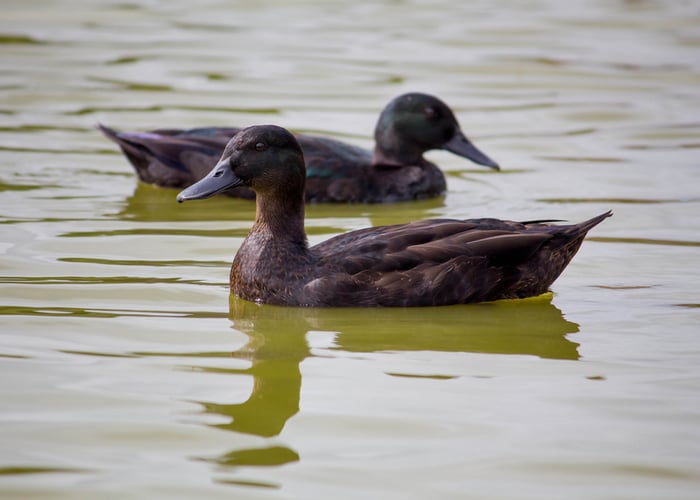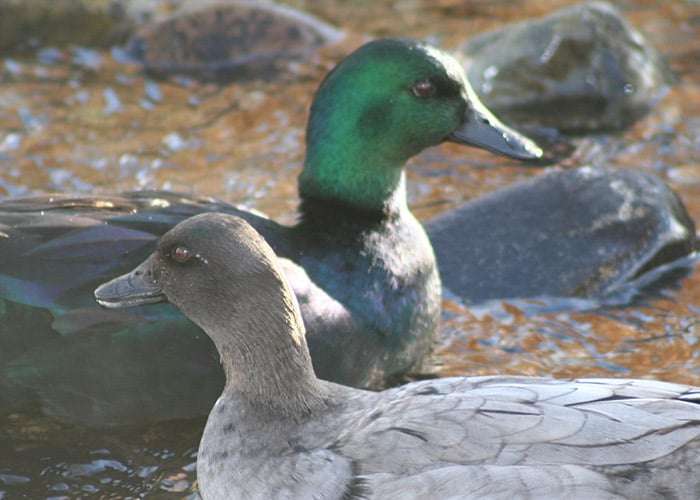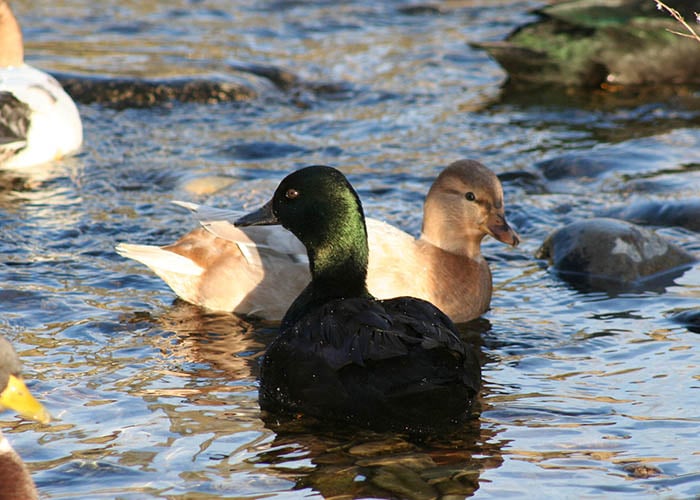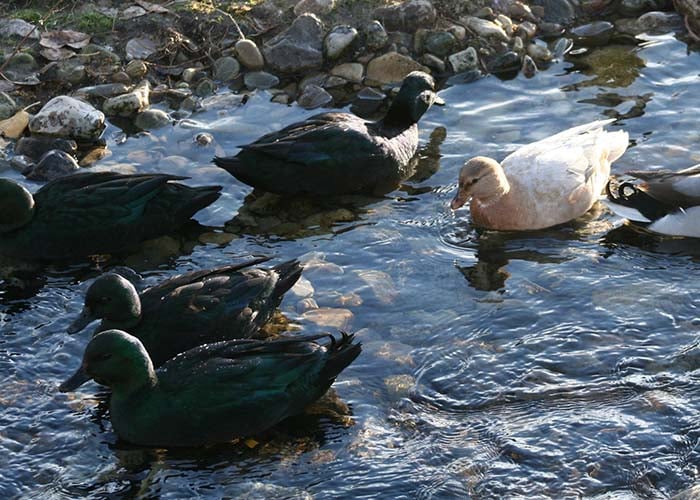East Indie ducks are one of the most beautiful breeds on the planet. Do not let their name fool you. We don’t believe this unique duck breed was originated in the East Indies but rather in the United States.
The East Indie duck and the Cayuga duck are quite similar and often mistaken for one another – even by experienced duck keepers. Both have iridescent coloring in dark shades and share the same type of epistatic gene colors. Cayuga ducks and East India ducks also lay eggs that feature a dark pigment that is easily washed off.
Members of this duck breed are typically kept as pond ornaments to showcase their beauty while lounging on the pond and showing birds. East India ducks are a bantam (small or miniature) breed that is a bit stockier than the most popular bantam duck breed – the Call duck.

East Indie Duck Breed History
During the time that this breed was developed, exotic birds of all types were the rage. This trend prompted the breed originators to dub this American duck breed the East Indie duck. People believed at the time that such an exotic-sounding name would help this new breed become quite popular – and profitable to keep and exhibit.
This breed was formally developed near the end of the 19th Century in the United States. Some folks have contended that East Indie ducks can be traced all the way back to 1831 in London. During that year, the Zoological Society of London had specimens of this duck breed and had dubbed them the “Buenos Ayres” duck.
In 1865, the United Kingdom standardized the East Indie duck breed. It was not until 1874 that this beautiful bantam duck breed was recognized and standardized by the American Poultry Association’s Standard of Perfection.
A group of professional artists chose the East Indie duck as the most beautiful bird of either land or waterfowl varieties after reviewing roughly 5,000 different species vying for the honor in 1943.
East Indie Duck Hen Facts
- Hens of this breed lay medium-sized dark gray to black eggs.
- As the laying season moves along, the eggs will become lighter in color. By winter, the eggs will often be a glistening shade of either green or blue.
- East Indie duck hens tend to turn white on their plumage as they get older. Even these old and white-colored hens can still produce pure iridescent black or purple and black ducklings if they are mated with a healthy and younger drake of the same breed. This bantam breed of duck is somewhat larger and racier of build than the Call Ducks.
- A mature East Indie duck hen should be expected to weigh in around 22 ounces.
- On average, an East Indie hens lay between 40 to 100 eggs annually.
- The incubation period for a fertilized egg from this breed is about 28 days.
- Momma hens of this breed are typically good sitters and attentive to their ducklings after they are born. The average sitting ability a hen possesses aside, it might still be wise to invest in an incubator if you want to develop a large flock, keep a sustainable flock, or plan to start a breeding business.
- Mature hens of this breed may also be prone to going broody during their laying cycle.
- While their laying numbers might slow down as they age, East Indie hens have been known to continue to lay eggs until they are eight or even nine years old.

East Indie Duck Drake Facts
- Drakes (and hens) reach maturity at around 10 weeks old.
- A mature East Indie drake weighs about 26 ounces.
- One healthy drake in his prime can often successfully and repeatedly mate with six to eight hens at a time.
- Drakes have a broad tail and webbed feet that are a shade of brown. The throat and forehead of an East Indie drake are a rosy shade of red.
East Indie Duck Breed Facts
- The average lifespan of an East Indie duck is approximately 10 years.
- The plumage on the East Indie duck’s upper portion is an iridescent and bronzish to green shade. The plumage below is a green to gray shade of both drakes and hens.
- Bills of either hens or drakes are medium in length, straight, and black in color.
- East Indie ducklings boast plumage that is brown to black in color. These little cuties also have black legs and black bills when they are born.
- On average, East Indie ducks are known as a quiet breed – they are far quieter than their bantam duck breed peers, the Call duck.
- East Indie ducks are prone to possessing an affable, calm, and even sometimes shy demeanor.
- These bantam ducks are excellent fliers. While they might migrate south for winter, they could also fly away when allowed to free-range unless their wings are regularly clipped. Even though they can fly away from your pond, keeping them in a duck run for at least several weeks will help teach the ducks that the area is both their home and a place of safety. It would be unusual for the whole flock to fly away from a spot of safety and food at once. Being a flock creature, one duck would not typically fly away from the rest unless they feel frightened or threatened.
More East Indie Duck Facts
- East Indie ducks are known as a hardy breed that is not overly susceptible to pests or illnesses. They do quite well on their own with minimal human intervention.
- These tiny ducks are superb free rangers and will forage and hunt for insects for hours on end inside of a large duck.
- Members of this breed can start being intentionally bred once they are about six months old.
- East Indie ducks have never been raised as meat birds because of their compact size and small weight. But, if you did want or need to butcher a member of this breed, the meat is prone to being moist and having a flavorful taste.
- While they can interact just fine with large duck breeds, East Indie ducks prefer to keep their own kind when given a choice. Keeping bantam and non-bantam duck breeds in the same coop/duck house and run would not likely result in any injuries among mature birds. Ducklings would likely get trampled and harmed or killed and should be removed to a brooder alone or a separate brooding habitat with their momma hen for the sake of safety.
- Cross-breeding an East Indie duck with any other breed except another bantam breed is highly discouraged for the hen’s health and safety. The weight of a full-size drake on top of a bantam hen during mating could be severely harmful, as could the large male sex organ and possibly the larger and heavier egg that would need to be played.
- Even though East Indie ducks are known to be docile, it is still recommended to use some care when approaching a drake that is steadfastly guarding a nest of eggs while the momma hen is briefly away garner something to eat, drink, or to go for a swim.

How Many is Too Many East Indie Ducks
If you only have space or finances to set up a small duck enclosure, keep at least three East Indie ducks together to simulate a flock environment to keep them happy … and possibly more healthy, too.
You do not need to have a pond to keep East Indie ducks. They can be equally happy with a baby pool to float and swim in. All ducks have to be able to, at a minimum, dip their heads into the water at least every three days to remain healthy. Duck nostrils must be kept moist to prevent serious to deadly health conditions.

East Indie Ducks and Wing Clipping
The only real downside to keeping East Indie ducks is the wing clipping required. This ensures they will not give in to their instinct to migrate or fly away if startled. The East Indie Duck seems to adapt quite well to a run. If you keep them entirely in a duck run, the wing clipping issue will not become a problem. Free-ranging provides them the most natural environment and diet possible and cuts down on feed costs. If you want to free-range East Indie ducks, you will need to learn how to properly and safely clip wings.
De-Worming the East Indie Duck
You’ll need to establish a regular de-worming routine. This is especially true if they will be duck house and run kept their entire lives. Ducks are generally far less prone to develop worm and parasite issues than other birds. This is because of their swimming and preening instincts. They still can fall victim to common poultry bird parasites. Ducks are messy creatures. Their droppings are large and watery. They splash in their baby pool water everywhere inside of their run. Keeping the ground in their run covered in fresh, natural material, like straw, hay, or sawdust shavings, will help. Straw dries up the mud and droppings mess and reduces the number of parasites that the ducks are exposed to.
Final Thoughts About the East Indie Duck
Keeping East Indie ducks in an enclosure with chickens may or may not work out well. I have always kept full-size and bantam chickens and ducks in the same enclosure without incident – but I free-range them all during the day. Other folks have had quite the opposite experience and suffered injuries among their duck and bantam chicken flocks. A little East Indie duck would be an easy victim if sharing quarters with a large and rowdy rooster.
Read Next: Crested Ducks



